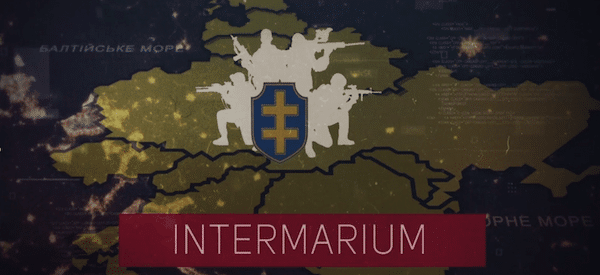The members of the Bucharest Nine (9) NATO eastern flank Allies (White House terminology) held a virtual summit today from the Romanian capital that lends it name to the group.
Participants also included President Joe Biden, Secretary of State Antony Blinken and North Atlantic Treaty Organization Secretary General Jens Stoltenberg. The participation of that trio should establish whose interests the group serves.
Though established in 2014, the real history of the Bucharest 9 goes back more than a century as will be demonstrated below, and has ominous implications for the worsening conflict between NATO and Russia.
Today’s event was hosted by Romanian President Klaus Iohannis and his Polish counterpart Andrzej Duda. The members of the group are Bulgaria, the Czech Republic, Estonia, Hungary, Latvia, Lithuania, Poland, Romania and Slovakia; all were absorbed into NATO from 1999-2004. All are former members of the Warsaw Pact, and with the exception of former East Germany (which entered NATO through its reunification with West Germany in 1989) and Albania (which left the Warsaw Pact in the 1960s and is itself now a NATO member), they were the Warsaw Pact outside of the Soviet Union, of which Estonia, Latvia and Lithuania were a part. After seven nations, six of which are now in the Bucharest 9, were admitted into the bloc in 2004, then-President George W. Bush made the pronouncement that the Warsaw Pact is now NATO. He was telling the simple truth.
The nine nations are the members of the Visegrad Four (the Czech Republic, Hungary, Poland and Slovakia), the three former Soviet Baltic states (Estonia, Latvia and Lithuania) and Black Sea neighbors Bulgaria and Romania. With Ukraine connecting them (it borders Hungary, Poland, Romania and Slovakia), the eastern flank is indeed just that. It is NATO’s cordon sanitaire along Russia’s western border.
NATO’s Stoltenberg went out of his way to fawn over President Biden, praising him twice in a brief message. In particular he celebrated the new American administration’s “commitment to rebuilding alliances” and “strengthening NATO.” Biden is the commander-in-chief the military bloc has been waiting for. Not since the inauguration of former NATO Supreme Allied Commander Europe Dwight Eisenhower in 1953 has a president arrived in the Oval Office as fully NATO interoperable as him.
Biden’s own comments, as reported in a White House readout, “underscored his commitment to rebuilding alliances and strengthening Transatlantic relations,” and “conveyed his desire for closer cooperation with our nine Allies in Central Europe and the Baltic and Black Sea regions on the full range of challenges….” The full range of challenges is reducible to one toponym: Russia.
He also vowed continued support for what is euphemistically referred to as NATO’s deterrence and defense policy, and stressed the need to strengthen cooperation against both “economic and political” actions by “our strategic competitors.” Again, that should be singular.
Both Biden and Stoltenberg highlighted the upcoming NATO summit on June 14.
Last year the foreign ministers of Lithuania, Poland and Ukraine met to create a regional cooperation group named the Lublin Triangle, in part to expedite Ukraine’s Euroatlantic integration; that expression is code for NATO and European Union membership.
A report of that event includes this paragraph:
This new format aims to bring the three countries closer together while also echoing their historical ties–namely the 17th century Lithuanian-Polish Commonwealth [16th-18th centuries] which included most of today’s Ukraine in its borders.
And another:
According to a joint statement released by the Ukrainian Ministry of Foreign Affairs, the signatories of the Lublin Triangle support Ukraine joining NATO, and believe that providing the country with a NATO membership action plan should be next step in this direction.
What the Lublin Triangle and the Bucharest 9 are at the least reflections of, but arguably the direct implementation of, are two projects from the early twentieth century devised and promoted by Polish political and military leader Józef Piłsudski: the Intermarium and Prometheism.
The first aimed to create a geopolitcal union of former parts of the Polish–Lithuanian Commonwealth lying on and between the Baltic, Black and Adriatic Seas, hence the name Intermariam (between the seas). Contra Russia. As first envisioned in the aftermath of World War I, the project was to include Belarus, Estonia, Finland, Latvia, Lithuania, Czechoslovakia, Hungary, Romania, Ukraine and Yugoslavia. Very close to what the Bucharest 9 is now.
The other though closely related plan was called Prometheism. Its purpose was to bring about the dissolution of Czarist Russia, later the Soviet Union, through the secession of non-Russian populations in the Baltic Sea, Black Sea and Caspian Sea regions. That was accomplished in 1991 with the emergence of independent Belarus, Estonia, Latvia and Lithuania on the Baltic Sea, of Georgia and Ukraine on the Black Sea, and of Azerbaijan, Kazakhstan and Turkmenistan on the Caspian Sea.
Having achieved the objective of Prometheism, the U.S. and NATO seem to be on the verge of accomplishing that of the Intermariam as well.

